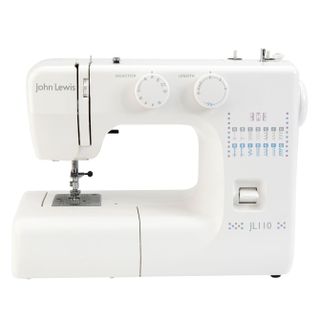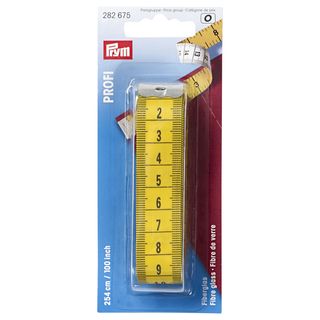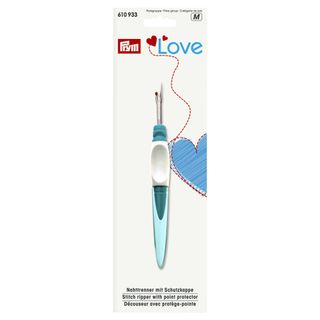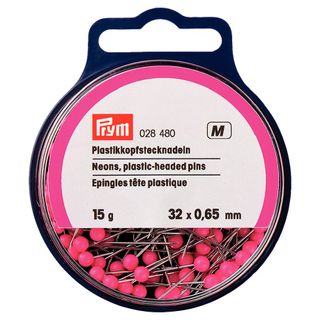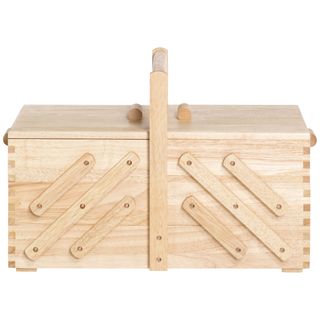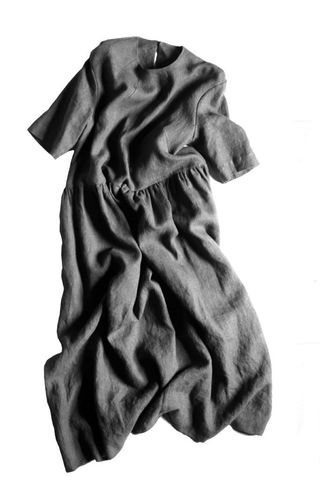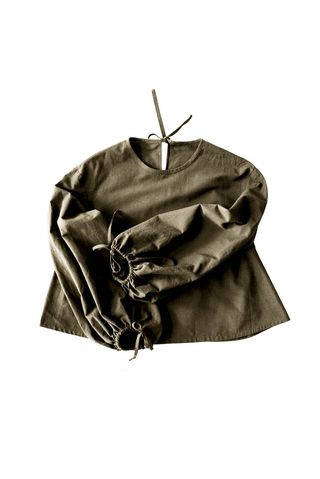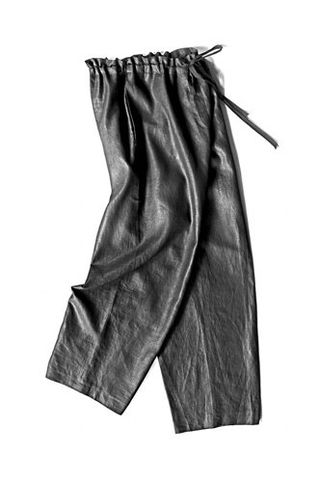I Taught Myself How to Sew, and It's Totally Changed the Way I See Clothes
Have you ever looked at your clothes, and I mean really looked? Have you studied the hidden intricacy of a hemline, or traced your finger along a French seam? Mentally deconstructed a skirt into its component parts, or followed the body-sculpting lines of a dart? Well, no—nor had I until I learned to sew.
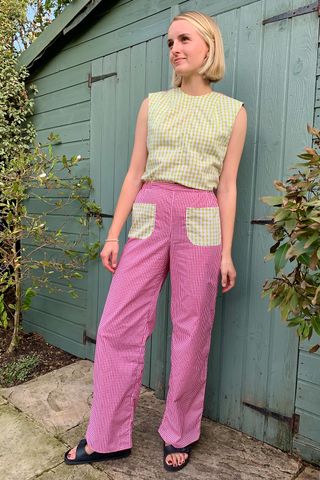
I made this matching top-and-trouser co-ord during lockdown using this super simple pattern. I added the patch pockets separately and adjusted the neckline to be more fitted.
Where It All Started
For years, my overriding memories of sewing were confined to secondary school textile classes: embroidering crooked purses to look like watermelon wedges and making wall hangings with "useful” pockets which gaped inelegantly. There was never a sense that home sewing was a particularly "cool” pastime, and the snobbery around wearing homemade clothing was still prevalent. It felt a world away from the fashion designers whose creations I pored over in glossy magazines, and it was hard to believe their cutting-edge appeal was born of the same DNA. Hacking off the hemline of a charity shop dress or safety-pinning a secondhand skirt were the limits of my DIY aspirations.
It was 10 years later, during a period of unemployment, that I found myself inexorably drawn back to sewing. The looming threat of idleness drove me through the doors of John Lewis’s Oxford Street store and into their haberdashery department. I purchased a cheap and cheerful sewing machine, and over the following two months, in the stifling heat of high summer, I furiously worked my way through piles of sewing patterns, starting with the most basic A-line skirts and sleeveless tops and graduating to vintage-inspired frocks with complex puffed sleeves and gathered skirts. It became a form of meditation, the whirr of the motor silencing needling worries, and though my future remained shrouded in uncertainty, the exacting and immersive nature of sewing gave me focus.
Fast forward four years, and I found myself yet again confined to the four corners of my home, but this time I was accompanied by the rest of the UK, as COVID-19 swept the globe: Birthdays were put on hold and weddings postponed, press events cancelled and after-work drinks a distant memory. The world was, and still is, facing irrevocable changes. The speed of city life ground to a halt—"slow living” no longer a lifestyle choice of woke twenty-somethings, but rather a new and enforced reality for many. The methodical appeal of crafts suddenly felt inexplicably fitting, and unlike 10 years ago, there was a modernised industry to answer our call.

This top was made from a pattern that was originally vintage but updated by Simplicity for modern sizes. I found this fun fabric at a market and thought it matched the ’50s aesthetic well.
The Emergence of a Modern Market
"More than five years ago, the home sewing market was still quite traditional, with only a handful of designers producing patterns, but since then we have seen the revival of different crafts, with sewing attracting many new followers,” says Rachel Walker, director of contemporary sewing website The Fold Line. "The sewing industry has responded to this surge in interest with an ever-growing number of new pattern designers and fabric ranges, also shows such as The Great British Sewing Bee have encouraged many more people to try sewing for the first time, particularly during lockdown.”
In the midst of lockdown malaise, making my own clothes has brought me the same sense of daily achievement that it did all those years ago, a craving that can’t quite be sated by another Zoom fitness class or Netflix binge. My homemade edit has swelled to include linen dresses, floral minis, a pair of checked trousers and a utility jacket for a friend’s 30th birthday. It seems I am not alone: John Lewis & Partners has seen a staggering 258% rise in sewing machine sales during lockdown, as people seek to pick up new hobbies. Meanwhile, high-end designers are even jumping on the DIY bandwagon, with JW Anderson releasing a knitting pattern for Harry Styles’s colourful patchwork cardigan in response to TikTok’s viral "cardigan challenge,” social media couldn’t get enough of it.
"The surge in making and craft, in general, has been lovely to see. Not only are we thinking more about how to use our time, especially when we’re off our screens, but we’re also excited to learn new skills”, says fashion influencer and home-sewer Zeena Shah. "Whilst there is fear of jobs and the economy, in general, it makes so much sense that you would try to upcycle a pre-loved garment rather than buy something new”

This is another dress that comes from the same pattern as the trousers and top. The loose fit felt very 2020, especially when paired with a linen-like beige fabric.
For many, it has been a chance to reconnect with their creative side, one that usually struggles to surface in the melee of normal life. "I fell into styling after university and I found it difficult to find time to make anything or do my own alterations,” Explains stylist and Who What Wear contributor Monikh Dale. "I found a seamstress I trusted so would give her all of my purchases, but this year in lockdown I decided to get back to it. Sometimes I might fall in love with an item, but at 5’1”, more often than not, I have to take it up to make it work for my frame. I love being able to create and alter something to fit my body, I find it so rewarding.”
Brands such as The Fold Line, Merchant & Mills and Wool & The Gang are leading the way in modernising the home sewing market by using up-to-date imagery and marketing trend-led sewing patterns that appeal to a younger, more sustainability-minded, audience. With no end in sight for social distancing measures, the fashion industry is under more pressure than ever to reassess its priorities and change its trajectory. Along with smaller, eco-friendly start-ups, sewing brands are offering a slower approach to consumerism, one that, by its very nature, promotes ethical production and supply chain transparency. As a home-sewer, you’re there every step of the way.
"I have always made my own clothes because I could never find exactly what I wanted on the high street. I wanted to make what I wanted to wear, and I hoped other people would want to wear them too,” explains Carolyn Denham, co-founder of contemporary pattern brand Merchant & Mills. "Home sewing has now become a true alternative to the high street, and companies like ours are now big enough to commission and produce more sustainable fabrics, championing the mills on every level and giving the home sewer the opportunity to be on the leading edge of sustainability.”
Where Style Meets Sustainability
For many sewers, myself included, learning to make our own clothing has brought into sharp relief the skill and time that goes into every item that we see hanging in high street stores. It’s a strange alchemy that sees disparate pieces of fabric joined together, puzzle-like, to create a fitted and finished whole, and it’s not something that should be taken for granted. While it takes five minutes to order something online from a global fashion platform, it can be weeks before a homemade piece is completed. The physical proximity to the sewing process binds me closer to my fashion choices.
"Until you make a piece of clothing from start to finish you won’t truly understand the hours and skill needed to create the pieces we buy on a daily basis,” says Zeena. "There is so much joy in the creative process, and so it is bittersweet to think that there are garment workers being paid unfairly for the amount of hours they put in to deliver pieces to our high street. Being able to make my own clothing has really opened my eyes to the way things are made and changed the way I shop.”
Luckily, there are a growing number of fashion brands that are answering the industry’s call for new and innovative solutions. Upcycling has seen a huge spike in popularity in 2020, as it offers labels a unique chance to combine the artisanal appeal of homemade craft with a demand for newness. Small brands, such as Mad Brown Knitwear, Leila Ray Vintage and Found & Curated Vintage, were all started by people who wanted to use their spare time to create one-of-a-kind pieces that have been lovingly revived, using both machine sewing and hand embroidery. The results are truly stunning.
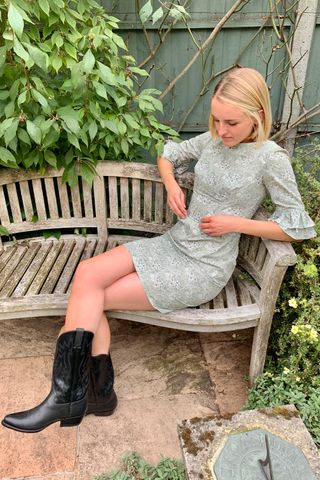
I love The Vampire’s Wife dresses, however, they are way over my budget, so I found a vintage pattern that offered the same fit and ruffled sleeves.
"I’ve always loved traditional knitwear, and I really valued the level of time and work that went into each garment. I wanted to find a way of treasuring the craftsmanship of traditional knitwear, while also bringing in some colour and creating new pieces that were sustainable,” says founder of Mad Brown Knitwear, Madeline Brown. "Most jumpers that come in are usually in need of some sort of repair. It may be holes that need stitching up or the replacement of a worn collar, so every knit starts with this slow process. Depending on the jumper it takes up to 30 hours to carefully embroider the coloured yarn into the knit. The long process is worth it to see the garment transform.”
For Found & Curated Vintage and Leila Ray Vintage, it was a love of secondhand fashion that inspired their founders to give pre-loved clothing a new lease of life. "I kept finding so many unused and forgotten beautiful vintage fabrics and felt that they had so much more love to give,” says Helen Emberton from Found & Curated Vintage. "We began to rework the fabrics—mostly 1940’s embroidered linens—into wearable items that could fit into modern-day wardrobes.”
Katie Black of Leila Ray Vintage has also seen unprecedented demand for her upcycled embroidery during lockdown: "High-end fashion brands are finally placing a spotlight on intricate hand workmanship, and I think showing this on platforms such as Instagram has educated a wider audience and garnered immense global appreciation,” she explains. "Also, Gen Z and millennials are becoming more sustainable shoppers and are increasingly searching for authentic garments with true provenance—they want reassurance that their clothing is ethically made.”
Fashion's Handmade Future
While we can applaud the work of these innovative individuals and pat ourselves on the back for buying a sewing machine, we need to acknowledge that sewing is a privilege of those with the luxury of time and also the money to buy the required tools and often-expensive fabrics. It is hardly the perfect solution to all of the industry’s sustainability problems. However, it feels like on a wider scale, the sewing revival presents an opportunity to re-invest in our relationship with fashion and show the next generation that clothing is something that should be valued.
"I’d love more people to take it up, but it’s definitely not an easy or quick hobby to jump into”, muses fashion influencer and pattern-cutter Georgia Meramo. "But I’m seeing a growing sewing community on TikTok, which is inspiring lots of younger people to enter the industry or try home sewing, which is really cool. Hopefully, this means it becomes more mainstream in the future.”

I wanted to sew something special for a friend’s 30th, and she requested a shacket. It was my biggest challenge to date, but the pattern was easy to follow ,and I was pretty happy with the outcome.
Why not make fashion and textiles a more integrated part of the school curriculum? And no, I don’t mean questionable wall decorations. Let’s teach students about supply chain ethics and sustainable fabrics, and allow them to sew something they actually want to wear. It will show them, firsthand, what really goes into the £5 tops they buy online. Plus, if we can encourage more fashion designers like JW Anderson to participate in this educational movement, we might finally be able to merge the disparate worlds of home sewing at high-end design.
"I feel that the biggest opportunity to make the home sewing industry even more exciting is having designers open up their runway collections to home sewists, not just ready-to-wear consumers,” argues Nicole Akong, one of the runners-up at this year’s Great British Sewing Bee. "This is actually the working concept behind my new fashion house, House of Akong, where all my fashion designs are available to buy and DIY. I truly believe that this is the future of high-fashion home sewing.”
If Nicole’s mission statement is anything to go by, I’m confident that there’s hope for the home sewing industry yet—teenage Joy would certainly approve. I have no doubt that the pandemic will precipitate a much-needed change in the fashion industry, but on a personal level it has brought me back to a purer enjoyment of clothing, one that has grown and flourished with every item of clothing I make and framed the way I shop: whether it’s buying quality over quantity, championing small, sustainable designers or simply asking, "Where were my clothes made?” One thing’s for sure: Fashion will never look the same again.
Scroll Down to Shop My Sewing Essentials
Up Next: The Vintage Revolution Is Coming—Here’s What You Need to Know
